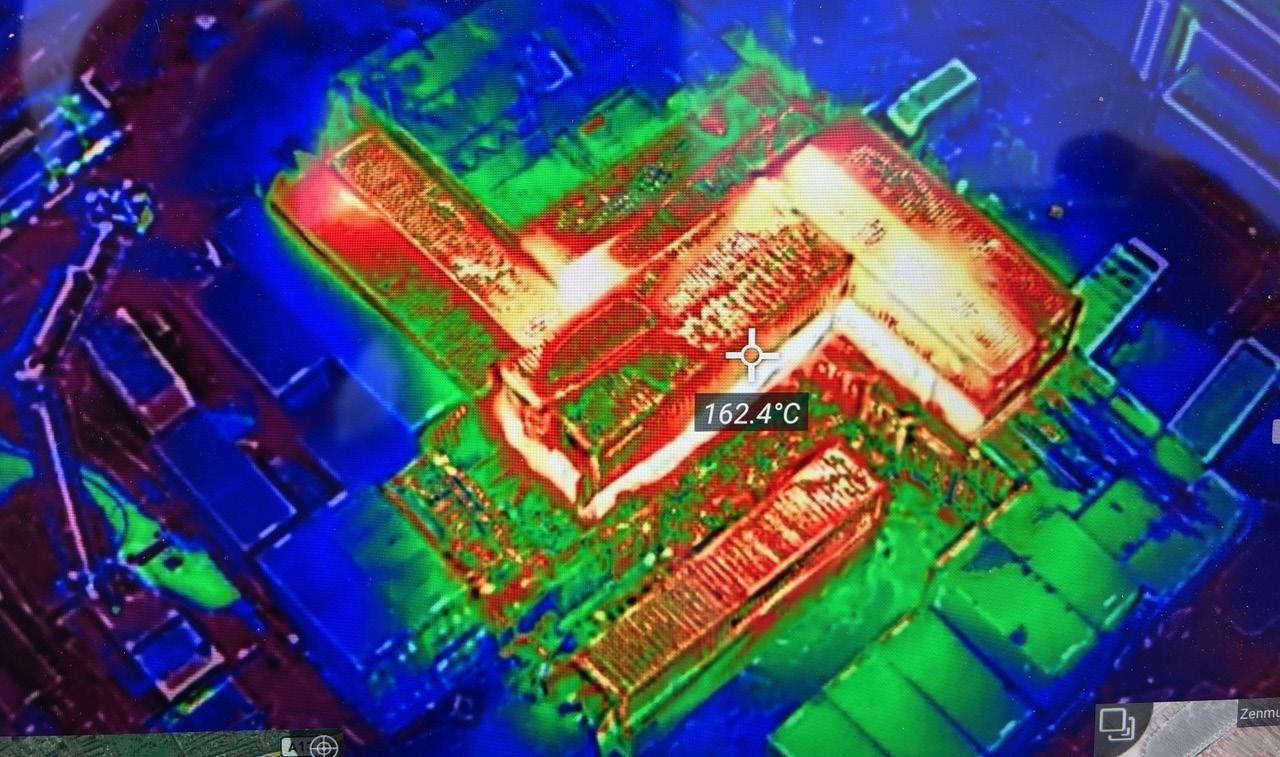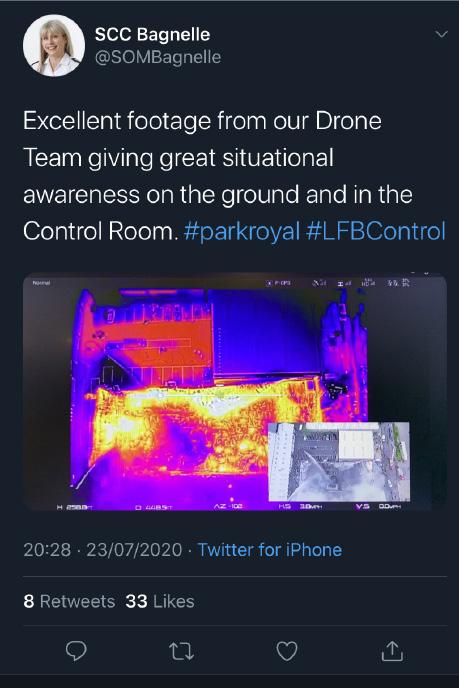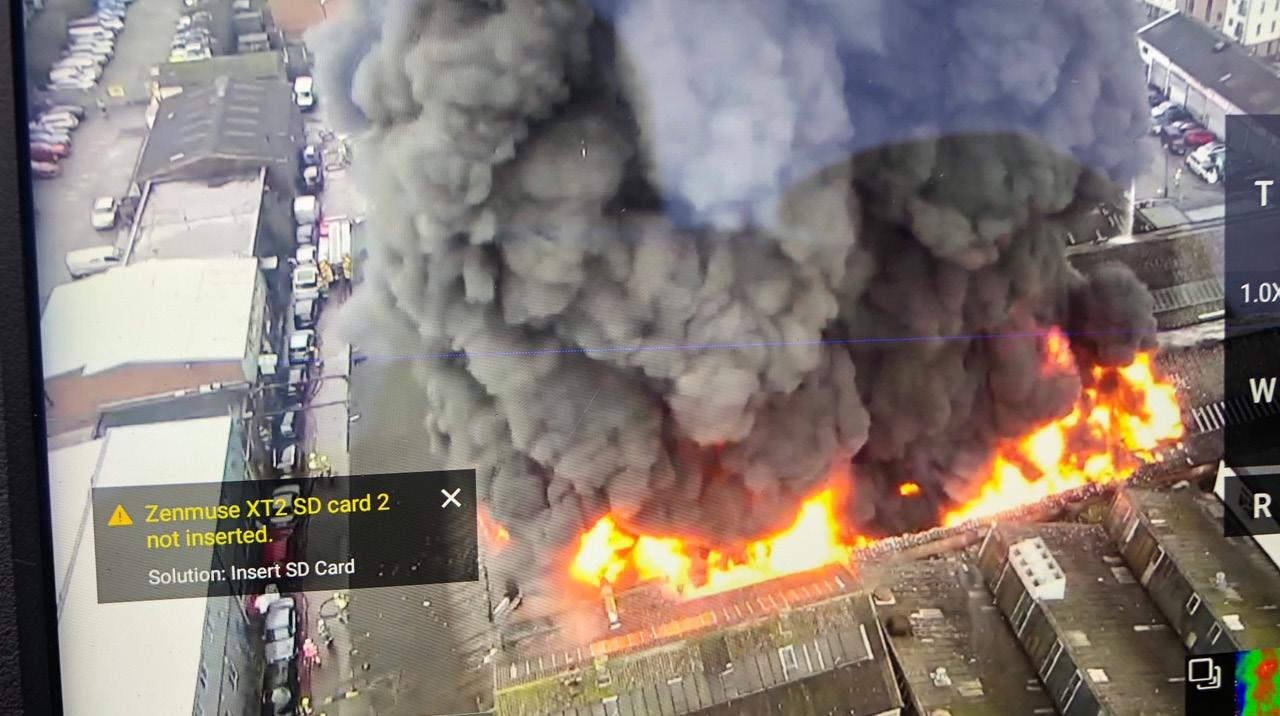
9 minute read
Drone Capability at London Fire Brigade
by Catalyst
DRONE CAPABILITY NEW TECHNOLOGY FEATURE DEMONSTRATES ITS WORTH
Drones give Incident Commanders an aerial view, increasing their situational awareness of fires. Station Officer Lee Newman details how the technology was implemented in London Fire Brigade and the continued benefits. The Grenfell Tower fire has resulted in revisions to a number of operational procedures and the introduction of new equipment in London Fire Brigade. However, one piece of new technology that was used at the project. My colleague Simon Stretch, had vast experience of flying drones with his family’s business and he seemed the ideal fit to take the technical side, leaving me to concentrate on the main project SOURCING DRONES Having covered off all the main bases to operating a drone, we then looked into what drone would best suit our needs on the fire ground. the Grenfell incident, albeit post fire, was Kent Fire and Rescue Service’s drone capability, which was tasked and admin role; this appointment paid dividends later, in the main trial phase. We spoke with various drone suppliers and arranged for private demos. We also asked other fire and to fly around the building to identify any external risks and assess building stability, providing essential safety information that facilitated ongoing internal firefighting operations in the Tower. A few months after the fire, I was asked to set up a trial to test the feasibility of London Fire Brigade having a drone capability of its own. GREAT OPPORTUNITY I had just joined the Operational Policy and Assurance Department having previously worked as a Watch Manager at a fire station when I was tasked at looking at a drone capability for the Brigade. I had never run a project before and I seized this new opportunity with great enthusiasm. Understandably, my first port of call was to visit the team at Kent FRS, The next hurdle I had to overcome was giving full consideration to all the Health and Safety (H&S) aspects of flying drones within an operational environment. To achieve this, I undertook a full Risk Assessment, working with the Brigade’s Head of Health and Safety to achieve the final paper. Then came the insurance and legal aspects of the project, which, as drone operations was a new concept for the Brigade, raised some new issues, but a workable solution was soon found. Finally, I had to consider how to manage processing imagery taken from incidents and still meet the requirements of GDPR.. As this was around the time GDPR was coming into effect, rather than inventing a rescue services about their drone capabilities and, after carefully considering all the information and feedback, we opted for the Matrice 210 V1 and a Phantom 4 as a trainer/reserve drone. We spoke to numerous companies about the possibility of leasing the drone and equipment as I felt we needed to have the option to return it if it did not meet the requirements agreed by the project board. This was resolved by reaching an agreement with a reputable supplier to lease the whole set up to the Brigade on a monthly basis, which enabled me to carry out the trial and extend it if needed (which still is ongoing) without any concerns of being burdened with an expensive set of equipment, should the pilot project have been unsuccessful. where I gathered all the information I could about how they went about getting their capability operational, including any advice on things they wished they’d done differently – there’s no point in making the same mistakes twice! My second idea – and one, it transpired, was one of my better ones – was to call on some drone expertise to share the workload of the technical and admin sides of new system I asked our Information Management team if I could use the process they used for processing the imagery from the Fire Investigation team. This meant we would just pass on the SD cards from any incident and the Information Management team would then be responsible for the processing, storing and deleting of files. This was a satisfactory solution agreed by the Brigade’s main GDPR advisor and the process was written into our Operations Manual. PILOT TRAINING To make the drone operational, the final piece of the puzzle was to select and train my team of pilots. We had bumped into Essex Police at the Drone Show in London at the end of 2017 and had struck up a good relationship with their drone team. As they were a National Qualified Entity for drone training, I contacted them in early 2018 and asked if they could put a course on for us. I had explored other drone training
Advertisement
centres but due to either being too expensive or too commercial, I opted for the Emergency Services bespoke course designed by Essex Police. The course was delivered in the summer of 2018 and was very well received by my team; we all passed and were PfCO qualified within the week. Once we had taken delivery of our drone package and had been trained on the new drone we decided to stay non-operational until all of the team had built up flight time and familiarisation with the new kit.
Our Operations Manual was written and submitted by Simon Stretch, my technical lead. Compiling the Operations Manual is a complex task and needs lots of attention and tweaking. This is where having two of us paid dividends – the whole drone operation is governed by the Manual and Simon was able to focus all of his attention on that, which allowed me to put all of my efforts into the admin side of the project. Sharing the workload meant that at no point did either of us become overloaded. This is one of the main learning points from the project for me and I’ve advised others thinking of starting a drone project about the benefits of splitting these two roles. The Civil Aviation Authority approved the final version of Simon’s Manual and we were ready to start operations as the Brigade drone team. OPERATIONAL TEAM From start to finish – from an idea on paper, researching other fire rescue service drone teams, asking for drone demos, getting the drone pilot qualifications and all of the admin between various departments in between – it took just nine months to get the drone team operational.
On its first day of being available for incidents the team received an order to attend a 15 pump fire at a leisure centre, which was under renovation. We were asked to confirm if there were cylinders on the roof of the building and immediately put the drone to use. The team flew and relayed the camera footage onto a large screen that was fitted into a van provided for the trial. The drone footage was able to identify, to the Incident Commander’s satisfaction, the cylinders were actually rolls of asphalt due to be laid on the roof as part of the renovation. If the drone concept could have been proven in one job this was it! The information from the drone allowed the Incident Commander to make a decision not to make it ‘cylinders confirmed’ and saved a lot of unnecessary extra appliance movements.
Since that first shout, the team has been called out to over 110 incidents of six pumps or more, including persons in water, people threatening to jump and also various missing
NEW TECHNOLOGY FEATURE
persons incidents both in London and into other counties, assisting police forces. Both Simon and I constantly try to stay ahead of the curve for drone technology and ideas, and recently managed to source a device which will allow us to stream live footage from the drone to Brigade Control. The team at Control will greatly benefit from seeing footage relating to the calls they’re receiving from the incident. We can also stream onto tablets, which gives both Sector Commanders and Incident Commanders better situational awareness and allows them to target their resources more efficiently. We also went as far as to stream onto the Commissioner’s and principal officers’ smartphones for incidents of note. We have received excellent feedback, with every officer who has been able to use this capability appreciating its usefulness at incidents. CAPABILITY TODAY The Brigade’s drone capability inventory today includes: a Matrice 210 V2 with a XT2 Thermal camera and Z30 optical; a DJI Mavic 2 Enterprise Dual with multi attachments; a Yuneec 520; a Teradek live streaming device and multiple tablets for receiving the streamed footage. We operate with two Mitsubishi Outlander PHEVs – plug-in hybrid SUVs – and have split the drone equipment into two, with one vehicle carrying the drone and batteries, and the other carrying all of the support kit and ancillaries. We now have eight pilots trained and operate a 24/7 service. The team is working closely with most elements of the Met Police drone department on joint training and also with Kent FRS and Essex Police. Other fire and rescue services have started to ask us for advice on how we started,

NEW TECHNOLOGY FEATURE
which I’m always more than happy to do considering how helpful we found the advice from Kent when we started on this

journey. At the beginning of the project I was following guidance from other people and services, the team was shaped around what I thought would be a good delivery method and how officers on the fire ground would like us to operate. This was certainly the case for half the time we’ve been operating but, recently, between Simon and I, the capability has been moulded to how we see the future and what it holds in the way of drone use. For example, we have just acquired another drone to explore how it might be used for technical rescue operations involving water. There’s also the possibility of combining two new concepts into one – London has just invested in fire escape hoods and I have already demonstrated how one might be delivered via a drone to a balcony above the height of an aerial appliance, while using the Mavic Enterprise 2 to relay instructions via the loudspeaker. These possible new uses are pushing the boundaries of our original concept but they both demonstrate how we aim to stay ahead of the curve, which in my opinion should be the aim of any drone team or emerging fire and rescue service drone project. That is my advice for a successful drone team, it should be one that enables a service to benefit greatly from the technology rather than be a hindrance and drain on service budgets.
www.london-fire.gov.uk and ISO 15384), which does not contribute to clarity.










